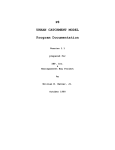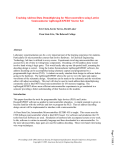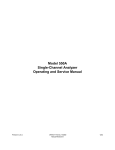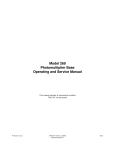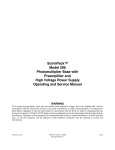Download Model 425A Delay Operating and Service Manual
Transcript
Model 425A
Delay
Operating and Service Manual
Printed in U.S.A.
ORTEC® Part No. 733190
Manual Revision F
1202
Advanced Measurement Technology, Inc.
®
®
a/k/a/ ORTEC , a subsidiary of AMETEK , Inc.
WARRANTY
ORTEC* warrants that the items will be delivered free from defects in material or workmanship. ORTEC makes no
other warranties, express or implied, and specifically NO WARRANTY OF MERCHANTABILITY OR FITNESS
FOR A PARTICULAR PURPOSE.
ORTEC’s exclusive liability is limited to repairing or replacing at ORTEC’s option, items found by ORTEC to be
defective in workmanship or materials within one year from the date of delivery. ORTEC’s liability on any claim of
any kind, including negligence, loss, or damages arising out of, connected with, or from the performance or breach
thereof, or from the manufacture, sale, delivery, resale, repair, or use of any item or services covered by this
agreement or purchase order, shall in no case exceed the price allocable to the item or service furnished or any part
thereof that gives rise to the claim. In the event ORTEC fails to manufacture or deliver items called for in this
agreement or purchase order, ORTEC’s exclusive liability and buyer’s exclusive remedy shall be release of the
buyer from the obligation to pay the purchase price. In no event shall ORTEC be liable for special or consequential
damages.
Quality Control
Before being approved for shipment, each ORTEC instrument must pass a stringent set of quality control tests
designed to expose any flaws in materials or workmanship. Permanent records of these tests are maintained for use
in warranty repair and as a source of statistical information for design improvements.
Repair Service
If it becomes necessary to return this instrument for repair, it is essential that Customer Services be contacted in
advance of its return so that a Return Authorization Number can be assigned to the unit. Also, ORTEC must be
informed, either in writing, by telephone [(865) 482-4411] or by facsimile transmission [(865) 483-2133], of the
nature of the fault of the instrument being returned and of the model, serial, and revision ("Rev" on rear panel)
numbers. Failure to do so may cause unnecessary delays in getting the unit repaired. The ORTEC standard
procedure requires that instruments returned for repair pass the same quality control tests that are used for newproduction instruments. Instruments that are returned should be packed so that they will withstand normal transit
handling and must be shipped PREPAID via Air Parcel Post or United Parcel Service to the designated ORTEC
repair center. The address label and the package should include the Return Authorization Number assigned.
Instruments being returned that are damaged in transit due to inadequate packing will be repaired at the sender's
expense, and it will be the sender's responsibility to make claim with the shipper. Instruments not in warranty should
follow the same procedure and ORTEC will provide a quotation.
Damage in Transit
Shipments should be examined immediately upon receipt for evidence of external or concealed damage. The carrier
making delivery should be notified immediately of any such damage, since the carrier is normally liable for damage
in shipment. Packing materials, waybills, and other such documentation should be preserved in order to establish
claims. After such notification to the carrier, please notify ORTEC of the circumstances so that assistance can be
provided in making damage claims and in providing replacement equipment, if necessary.
Copyright © 2002, Advanced Measurement Technology, Inc. All rights reserved.
*ORTEC® is a registered trademark of Advanced Measurement Technology, Inc. All other trademarks used herein
are the property of their respective owners.
iii
CONTENTS
WARRANTY……………………………………………………………………………………………………….. ii
SAFETY INSTRUCTIONS AND SYMBOLS……………………………………………………………………..iv
SAFETY WARNINGS AND CLEANING INSTRUCTIONS……………………………………………………..v
1. DESCRIPTION………………………………………………………………………………………………… 1
2. SPECIFICATIONS…………………………………………………………………………………………….. 1
3. THEORY……………………………………………………………………………………………………….. 1
4. MAINTENANCE……………………………………………………………………………………………….. 3
5. BIBLIOGRAPHY………………………………………………………………………………………………. 4
iv
SAFETY INSTRUCTIONS AND SYMBOLS
This manual contains up to three levels of safety instructions that must be observed in order to avoid personal
injury and/or damage to equipment or other property. These are:
DANGER Indicates a hazard that could result in death or serious bodily harm if the safety instruction is not
observed.
WARNING
Indicates a hazard that could result in bodily harm if the safety instruction is not observed.
CAUTION
observed.
Indicates a hazard that could result in property damage if the safety instruction is not
Please read all safety instructions carefully and make sure you understand them fully before attempting to
use this product.
In addition, the following symbol may appear on the product:
Please read all safety instructions carefully and make sure you understand them fully before attempting to
use this product.
v
SAFETY WARNINGS AND CLEANING INSTRUCTIONS
Cleaning Instructions
To clean the instrument exterior:
•
•
Unplug the instrument from the ac power supply.
Remove loose dust on the outside of the instrument with a lint-free cloth.
•
Remove remaining dirt with a lint-free cloth dampened in a general-purpose detergent and water
solution. Do not use abrasive cleaners.
•
Allow the instrument to dry completely before reconnecting it to the power source.
vi
1
ORTEC MODEL 425A
DELAY
1. DESCRIPTION
The 425A Delay is a single-width NIM-standard
module that provides for signal delays in 1-ns
steps from 1.7 to 64.7 ns. This is the basic 1.7-ns
instrument delay plus the switch-selected
additional delay. Longer delays may be achieved
by cascading several 425A modules. Input and
output impedances are 50Ω. The delays are
accomplished by coaxial cables interconnected by
strip-line sections; no power is required. Delay
accuracy and definition are discussed in Section 3,
“Theory.”
2. SPECIFICATIONS
Input
50 Ω impedance, either polarity; 1500 V
maximum BNC connector.
Delay Accuracy ±100 picosecond or ±1% for
each delay section used; whichever is greater.
Output 50 Ω impedance, delay is the sum of IN
switches; BNC connector.
Cable Type RG-58A/U.
Power Required None.
Delay Lengths 1, 2, 4, 8, 16, and 32 ns; may be
added in any combination.
Minimum Delay 1.7 ns (all switches OUT).
Dimensions
Standard single-width module
(1.35 in. wide × 8.714 in. high) per TID-20893
(Rev).
3. THEORY
Pulses transmitted through coaxial cables suffer
both attenuation and distortion. In the cable used
in the 425A, as in most cables commonly used for
pulse work, skin effect losses in the conductor are
the predominant losses for frequency components
below approximately 1000 MHz. Skin effect losses
result in high-frequency attenuation which,
½
expressed in decibels, increases as (ω) .
An ideal step-function pulse impressed on the line
appears at the (matched) far end with the shape
shown in Fig. 1.
The rise time from 0 to X percent can be
expressed as multiples of T0, where T0 is the 0 to
50% rise time. Table 1 presents some rise-time
conversion factors; an example of the use of these
factors is the following: 10% to 90% rise
time = (29.0 ? 0.17) T0 = 28.83 T0.
In Fig. 2, T0 is plotted against the delay length in
Nanoseconds
2
so different, the overall rise time of combinations
cannot be calculated from the square root of the
sum of squares of individual rise times, either
with cables alone or with cables combined with
Gaussian elements. Instead, the overall response
of a system with cables and other elements may
be obtained graphically or with convolution
integrals (ref.3)*, using either step or impulse
(obtained from the derivative of the function
plotted in Fig. 1) function responses.
Since the rise time is proportional to the square of
the length, if two equal lengths of a given type of
cable are cascaded, the rise time of the
combination is four times the rise time of either
length alone. This is in contrast to the familiar case
of amplifiers of Gaussian frequency response, in
which the rise time varies as the square root of the
number of identical sections. For this reason and
also because the characteristic step-function
responses of cables and of Gaussian devices are
The above discussion makes it clear that the
delay of a cable cannot be specified unless the
point on the response function is specified. For
the 425A Delay, an operational definition is
chosen. When the required delay has been
selected by any one of the IN switches, the 50%
amplitude point will be delayed by an amount
equal to the delay that would be effected by
lossless delay line. One example will serve to
explain the sense in which this definition is
operational. Two counters (scintillation) detect
prompt coincidence gamma rays from a
radioactive source. The source is moved 120 cm
away from one counter and 120 cm closer to the
other. If the cable delay from one counter is
changed by 8 ns by use of the 425A, the two
counters will be properly time-realigned if the
discriminators associated with each counter are
operated at 50% amplitude. In practice, the
experimenter cannot readily operate at 50%
amplitude just to have the cable calibrations
meaningful, but, using Eq. (1), it can be seen that
the timing difference between 0% and 50%
amplitude is less than 20 ps for a 10-ns length of
RG-58A/U. It is in this range of operation that
discriminators are usually used. If the
discriminator is to be used at a large percentage
of full amplitude or if long delays are to be
achieved at settings other than 50%, corrections
can be made by using Fig. 1 or Table 1 as a
reference. For the above example, a delay error
of 0.26 ns would result if the discriminator were
operated at the 90% level.
Figure 3 shows the block diagram of the
apparatus used in testing the delay cables of the
425A.
A fast-rising pulse is split into two branches, one
of which is the 425A Delay. The other consists of
sections of high-quality rigid air lines with one
adjustable section. The delays between the
*See Section 5, “Bibliography.”
3
(~1 ns) also affects both branches equally, and
so it introduces only second-order errors. Also,
the air cables are not exactly lossless, but the T0
is almost 2 orders of magnitude shorter than for
RG-58A/U, so it can be neglected.
If a transmission line system were to introduce no
reflections, it would have to have a uniform
discriminators and the coincidence circuit are
adjusted to the middle of the edge of the decay
curve, i.e., 50% count rate. The width of this edge
is about 20 ps; that is, changing the adjustable air
line by 20 ps can change the output counting rate
from 100% to 0%. When a delay is switched into
the 425A branch, the equivalent length of air line is
introduced into the other branch. If the delay cable
has the correct length, the count rate will again be
50%; if not, the amount of required readjustment
of the variable air line gives the error directly. Both
discriminators operate at 50% amplitude for this
test.
The termination of the cable at any realizable
discriminator input is not exactly 50 Ω. Commonly
used circuits include the shunt capacity of a tunnel
diode or the base of a fast transistor plus stray
inductances and capacitances. This slight
deviation from perfect termination does not affect
the delay definition appreciably because it is the
same in both branches. Finite test pulse rise time
of inductance to capacitance at each point would
have to be a constant. This cannot be achieved
even for the cable itself, and further deviations
occur when cables must be interconnected and
the pulses routed through switches. At points of
interconnection where excess inductance is
encountered, some small capacitance has been
purposely added, so that the ratio of L/C
averaged over the connection is correct.
Likewise, the switches have been mounted so
that averaged over the switch gives 50 Ω, even
though from point to point there are deviations.
Thus reflections occur when the magnitude of the
deviations and the distance over which they
extend become appreciable when compared to
the distance traversed by a pulse during its rise
time (ref. 8) For most pulses used in data
acquisition systems in the physics laboratory in
which the rise time is equal to or greater than 1
ns, the reflection introduced at each end of the
each delay cable will be comparable in size to
that incurred when two cables are connected
together by BNC connectors and a BNC union.
The temperature coefficient of the delay of the
cables used in the 425A is about 150 ppm/°C
within 20° of room temperature.
4. MAINTENANCE
The assembly procedures peculiar to the 425A
Delay are considered virtually irreversible;
therefore, any warranty problems will be resolved
by replacement of the module.
4
5. BIBLIOGRAPHY
1. S. Goldman, Transformation Calculus and Electrical Transients, Prentice-Hall, New York, 1945.
2. P. Behrend, “Theory of Pulse Technique for Coaxial Cables,” Z. Angnew. Physik 5, 61 (February, 1953).
3. R. L. Wigington and N. S. Nahman, “Transient Analysis of Coaxial Cables Considering Skin Effect,” Proc.
IRE 45, 166- 174 (February, 1957).
4. Q. Kerns, F. Kirsten, and C. Winningstad, Pulse Response of Coaxial Cables, revised by R. Kirsten, LRL
Counting Note CC 2-1, Lawrence Radiation Laboratory, University of California, Berkeley, 1959.
5. W. C. Johnson, Transmission LInes and Networks, McGraw-Hill, New York, 1950.
6. H. H. Skilling, Electric Transmission Lines, McGraw-Hill, New York, 1951.
7. R. Littauer, Pulse Electronics, McGraw-Hill, New York, 1965.
8. Hewlett-Packard Company, Time Domain Reflectometry, Application Note 62.










